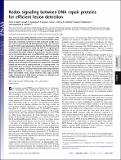| dc.contributor.author | Barton, Jacqueline K. | |
| dc.contributor.author | Gralnick, Jeffrey A. | |
| dc.contributor.author | Sontz, Pamela A. | |
| dc.contributor.author | Genereux, Joseph C. | |
| dc.contributor.author | Boal, Amie K. | |
| dc.contributor.author | Newman, Dianne K | |
| dc.date.accessioned | 2010-05-05T16:59:30Z | |
| dc.date.available | 2010-05-05T16:59:30Z | |
| dc.date.issued | 2009-08 | |
| dc.date.submitted | 2009-07 | |
| dc.identifier.issn | 1091-6490 | |
| dc.identifier.issn | 0027-8424 | |
| dc.identifier.uri | http://hdl.handle.net/1721.1/54715 | |
| dc.description.abstract | Base excision repair (BER) enzymes maintain the integrity of the genome, and in humans, BER mutations are associated with cancer. Given the remarkable sensitivity of DNA-mediated charge transport (CT) to mismatched and damaged base pairs, we have proposed that DNA repair glycosylases (EndoIII and MutY) containing a redox-active [4Fe4S] cluster could use DNA CT in signaling one another to search cooperatively for damage in the genome. Here, we examine this model, where we estimate that electron transfers over a few hundred base pairs are sufficient for rapid interrogation of the full genome. Using atomic force microscopy, we found a redistribution of repair proteins onto DNA strands containing a single base mismatch, consistent with our model for CT scanning. We also demonstrated in Escherichia coli a cooperativity between EndoIII and MutY that is predicted by the CT scanning model. This relationship does not require the enzymatic activity of the glycosylase. Y82A EndoIII, a mutation that renders the protein deficient in DNA-mediated CT, however, inhibits cooperativity between MutY and EndoIII. These results illustrate how repair proteins might efficiently locate DNA lesions and point to a biological role for DNA-mediated CT within the cell. | en |
| dc.language.iso | en_US | |
| dc.publisher | United States National Academy of Sciences | en |
| dc.relation.isversionof | http://dx.doi.org/10.1073/pnas.0908059106 | en |
| dc.rights | Article is made available in accordance with the publisher's policy and may be subject to US copyright law. Please refer to the publisher's site for terms of use. | en |
| dc.source | PNAS | en |
| dc.title | Redox signaling between DNA repair proteins for efficient lesion detection | en |
| dc.type | Article | en |
| dc.identifier.citation | Boal, Amie K et al. “Redox signaling between DNA repair proteins for efficient lesion detection.” Proceedings of the National Academy of Sciences 106.36 (2009): 15237-15242. © 2009 National Academy of Sciences | en |
| dc.contributor.department | Massachusetts Institute of Technology. Department of Biology | en_US |
| dc.contributor.department | Massachusetts Institute of Technology. Department of Earth, Atmospheric, and Planetary Sciences | en_US |
| dc.contributor.approver | Newman, Dianne K. | |
| dc.contributor.mitauthor | Newman, Dianne K. | |
| dc.relation.journal | Proceedings of the National Academy of Sciences of the United States of America | en |
| dc.eprint.version | Final published version | en |
| dc.type.uri | http://purl.org/eprint/type/JournalArticle | en |
| eprint.status | http://purl.org/eprint/status/PeerReviewed | en |
| dspace.orderedauthors | Boal, A. K.; Genereux, J. C.; Sontz, P. A.; Gralnick, J. A.; Newman, D. K.; Barton, J. K. | en |
| mit.license | PUBLISHER_POLICY | en |
| mit.metadata.status | Complete | |
